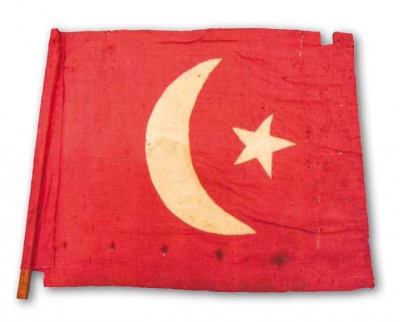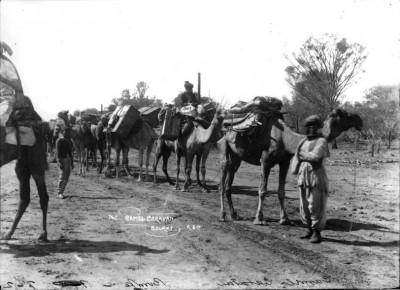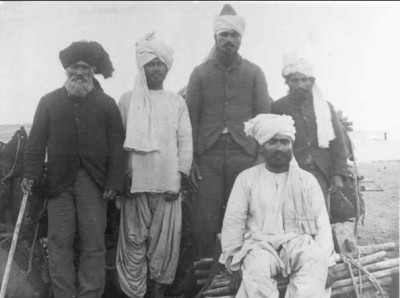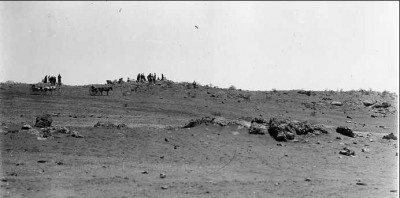Era: 1914 - 1918 Cultural background: Afghan, English, German Collection: Justice & Police Museum Theme:Federation Gaol German Internment Labour Movement Prisoners of War Religion Riots Settlement WW1
Collection
Justice & Police Museum, Sydney, Australia.
Object name and number
Broken Hill Ottoman Flag.
Object Description
A red cotton flag with yellow crescent moon and star cotton insignia sewn onto it to create the 19th century flag Ottoman Flag that was adopted by Turkey as the national flag in 1936. The flag is mounted on a section of wood. Dimension approximately 500mm wide x 400mm high.
There were some fifteen Aboriginal groups living in the Darling River area on the western plains of New South Wales. The main group at Broken Hill was the Wiljakali1. Their territory was expansive because of the dry drought prone environment. The Wiljakali lived a traditional lifestyle into the 1870s, but by the 1880s their way of life was changing with many Aboriginal people getting work on sheep stations and in mining.
Broken Hill was named by the British Explorer Charles Sturt during his search for an inland sea in 1844. Western plains towns far away from the Darling River, such as Broken Hill, exist because of mining after 1875, when huge deposits of gold, silver, copper and opal were found.
The township of Broken Hill was developed in the ‘Broken Hill Paddock’ on the Mt Gipps Station. In 1883 that three Station workers pegged the first mineral lease on this property. A township was soon surveyed in 1883 and Broken Hill was initially known as a shanty town with an entire suburb named ‘Canvas Town’ for its temporary buildings.
As European settlement moved further west beyond Bourke it became clear that horses would not provide a sustainable mode of transport.
The solution was to import camels. Afghan cameleers were recruited to Australia to handle the camels. The introduction of camels and Afghan cameleers proved to be a turning point in the exploration and development of the Australian interior.
The most successful of all the Afghan cameleers was Abdul Wade. Wade arrived in Australia in 1879 and initially worked for Faiz and Tagh Mahomet in South Australia. In 1893, Wade moved to Bourke and began importing camels and recruiting Afghan cameleers for the recently formed Bourke Camel Carrying Co. Dost Mahomet was a prominent Afghan camel driver who worked at Broken Hill. His grave lies three kilometres from Menindee, on the road to Broken Hill. He is thought to be the first Islamic person to be buried on Australian soil.
Cameleers led hundreds of camel trains throughout inland Australia in the nineteenth century and by the turn of the twentieth century their camel trains provided transport for almost every major inland development project. The cameleers laboured across the continent, carting produce, water, mail and equipment at a time when roads and railways were not constructed. The hardy camels and their drivers were crucial to the success of important projects such as the construction of the Overland Telegraph. The early Cameleers contributed greatly to the development of rural and remote Australia.
Over 20,000 camels were brought to Australia from 1850 to 1900 from different parts of the world. The cameleers came from different countries such as Kashmir, Rajastan, Egypt, Persia, Turkey, Punjab, Baluchistan, Afghanistan, India and Pakistan. They were known as “Afghans,” although very few were actually from Afghanistan.
Camels at Broken Hill were imported Sir Thomas Elder in 1866 for work in northern South Australia. The ‘ Ghans’ as they became known, were working the area before Broken Hill’s establishment in 1883 and the Afghan camel teams were a familiar sight in the far west of NSW. Camels were used to haul wool on ten ton drays travelling at a rate at 15 miles per day. When they struck camp the Afghans slept in a temporary corrugated-iron shed or humpy of tree branches. They led a nomadic life with few personal possessions. They were followers of Islamic who did not drink alcohol. Because of their sobriety they were favoured as reliable workers and carting alcohol to the outback hotels.
Afghan camel teams played a crucial role in exploratory expeditions and scientific survey parties into the outback. Afghans were among the first non-Aboriginal people to sight Uluru and the Karlu Karlu. They had their own names given to places such as Allanah’s Hill and Kamran’s.
The Afghans traveled lightly and were always ready to move. Like the Chinese Station workers the Afghans were on short term work contracts that did not allow their wives or children to travel with them to Australia. Many men worked and lived communally observing strict religious practices that discouraged extensive interaction with the European workers and outback towns. As a result the Afghans generally lived away from Europeans in makeshift camel camps and later developed ‘Ghantowns’ on the edges of stations and towns. Mostly they were solitary travelers deprived of the sense of community or ‘Ummah’ of Islamic culture.
On the 1st of January 1915. Two men shot dead four people and wounded seven more, before being killed by Police and Army.
While the attack was apparently politically inspired, as the attackers confessed in notes they left behind, it appears they were not involved in any organised group or militia. World Way One had erupted in July 1914 and Turkey was one of the Central Powers the Australia and its Allies were at war with. So it was speculated that the two men were Turkish. Later they were identified as Muslims from what is now modern day Pakistan.
The attackers were both former cameleers working at Broken Hill. They were Badsha Mohammed Gool, an ice-cream vendor and Mullah Abdullah, a local imam and halal butcher.
Gool’s ice-cream cart was well-known in town and was used to transport the men to the attack site. They made a home-made Ottoman flag which they flew. There appears to have been little effort at hiding their identities.
Abdullah had arrived in Broken Hill around 1898 and worked as a cameleer, before becoming a Islamic mullah and slaughtering animals according to halal Islamic law.
Several days before the attack Abdullah was convicted by Chief Sanitary Inspector Brosnan for slaughtering sheep on premises not licensed for slaughtering. Apparently this was not his first charge. Because the butchers trade union had racially discriminatory rules at the time and abattoirs had union only employment rules, Abdullah could not legally prepare halal meats for the Muslim community. A further grievance was he had removed his cultural identity by ceasing to wear his turban years before because ‘larrikins’ threw stones at him and harassed him.
Gool lived next door to Mullah Adbullah. Gool was a member of the Afridi, a Pashtun clan, from Afghanistan. He bragged he had been in the Turkish Army and was believed to regularly smoke strong marijuana. Police Constable Mills later believed that Gool had manipulated Abdullah’s resentment of Sanitary Inspector Brosnan and the fines to take part in the attack.
Each New Year’s Day the local lodge of the Manchester Unity Order of Oddfellows held a picnic at Silverton. That day the train from Broken Hill to Silverton was crowded with 1200 picnickers on 40 open trucks. Three kilometres out of town, Gool and Abdullah positioned themselves on the embankment about 30 metres from the tracks. As the train passed they opened fire with two rifles firing around 30 rounds.
The crowd originally thought the shots were in honour of the train passing, but once people started to fall around them the crowd panicked. Two passengers, William Shaw, the Foreman of the Sanitation Department, and Elma Cowie were killed. Six passengers, Mary Kavanagh, George Stokes, Thomas Campbell, Lucy Shaw, Alma Crocker and Rose Crabb were wounded.
Gool and Mulla escaped towards the West Cameleers Camp where they lived. On the way they murdered Alfred E. Millard who had taken shelter in his hut. The survivors on the train contacted the Police who contacted Lieutenant Resch at the local Army base who despatched the local Militia and an Army Unit to capture them.
When Police encountered Gool and Abdullah near the Cable Hotel, the pair shot and wounded Constable Mills. Gool and Abdullah took shelter among a white quartz outcrop known as Cable Hill that provided good cover. A 90 minute gun battle followed, during which armed civilians arrived to join the Police, Militia and Army.
James Craig, who was chopping wood 500 meters away during a gun battle was hit by a stray bullet and killed. He was the fourth victim to be killed.
At one o’clock a rush took place to the Turks’ stronghold. An eyewitness later stated that Gool had stood with a white cloth tied to his rifle but was cut down by gunfire.
In the battle there was a desperate determination to leave no work for the hangman, or to run the risk of the murderers of peaceful citizens being allowed to escape. It was not a long battle. The attacking party was being constantly reinforced by eager men, who arrived in any vehicles they could obtain or on foot. At just about one o’clock a rush took place to the Turks stronghold, and they were found lying on the ground behind their shelter. Both had many wounds, One was dead, the other expired at the Hospital later. They were in the dress of their people, with turbans on their heads. The Police took charge of the bodies. Barrier Miner, 2nd January, 1915
The attackers left notes explaining that their grievances were connected to the hostilities between the Ottoman and British Empires which had been officially declared in October 1914. Believing he would be killed, Gool Mohamed left a letter in his waist belt, which stated that he was a subject of the Ottoman Sultan and that, I must kill your men and give my life for my faith by order of the Sultan.
Mullah Abdullah wrote that he was dying for his faith and in obedience to the order of the Sultan, “but owing to my grudge against Chief Sanitary Inspector Brosnan it was my intention to kill him first. Beyond this there is no enmity against anybody, and we informed nobody.’
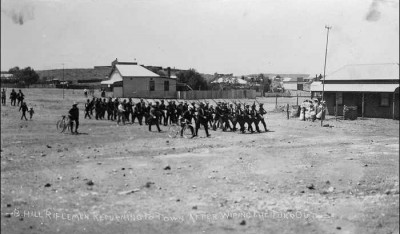
Men marching back to Broken Hill the day after the attack. Courtesy of the State Library of South Australia
After the battle the scene in Broken Hill was pandemonium – townsfolk would not allow Abdulla’s body to be taken away in an ambulance and it was finally removed in an old dray. Later that day both the bodies of Abdulla and Mohamed were disposed of by the Police in secret operation. The following night the Police were forced to stop a mob from marching on the West Cameleer’s camp.
Afterwards there was no violence recorded against the Broken Hill Muslim community. Instead, the attack was seen as the result of seditious activities of ‘enemy aliens’ and the German Community in the area became the focus of mob violence. Believing the Germans had agitated the assailants to attack the train, the local German Club was burnt to ground with the angry mob cutting the hoses of the firemen who came to fight the flames. Once again the Police had to break up the mob.
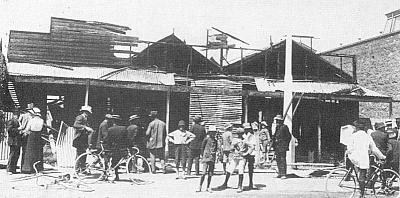
The German Club House in Broken Hill, NSW, was attacked in January 1915. The building had been unoccupied since the outbreak of war. Courtesy of the Broken Hill Historical Society
The next day the mines of Broken Hill fired all employees deemed ‘enemy aliens’ under the 1914 Commonwealth War Precautions Act. Six Austrians, four Germans and one Turk were ordered out of town by the mob. Shortly after prominent members of the Australian German Community were forced to register with Police as ‘enemy aliens’ in Australia were interned Holsworthy Concentration Camp for the duration of the war.
The Broken Hill Ottoman Flag is historically significant as evidence of early cameleering, the history of Broken Hill and of the cultural ethnic tensions that undercurrent in Australian and all settler history. It is evidence of the insensitivity of Europeans to ethnic minorities despite the obvious contribution the ‘Afghans’ made to opening up the outback and the in construction of the overland telegraph.
The Broken Hill Ottoman Flag is rare being unique and one a few items from the New Years Day attack at Broken Hill in 1915.
The Broken Hill Ottoman Flag has social significance for the Australian Islamic Community for its association with the cameleers, who came from different parts of the Middle East. These men made a vital contribution by significantly opening up the outback, constructing overland telegraph lines which connected NSW to London, constructing railways, erecting fences, acting as guides for several major expeditions, as well as supplying almost every inland mine or station with its goods and services. The flag has social significance to the families of those killed and injured in the attacked as a symbol of the tension of that event.
The Broken Hill Ottoman Flag has aesthetic significance for its blending of traditional Islamic design and motifs to create the crescent moon and star the symbols of the Ottoman Empire and Islam. It provides evidence of a Middle Eastern and Islamic cultural identity in Australia.
The Broken Hill Ottoman Flag has research value role as a rare source of information which offers material evidence of this poorly documented aspect of early Australian outback settlement and history.
The Broken Hill Ottoman Flag has interpretive significance as evidence of the social tensions between Christian and Islamic cultures and communities in out back New South Wales. It represents an unfortunate flash point in tensions between Europeans and the ‘Afghans’ at the outset of World War One. The cultural insensitivity that sparked the attack provides an insight to the Islamic community approach to survival and adaptation to life in a foreign country.
Footnotes
/07_subnav_01_2.cfm?itemid=5051563
Bibliography
Coupe, S & Andrews, M 1992, Was it only Yesterday? Australia in the Twentieth Century World, Longman Cheshire, Sydney.
Heritage Office & Dept of Urban Affairs & Planning 1996, Regional Histories of NSW, Sydney.
Heritage Collections Council 2001, Significance: A guide to assessing the significance of cultural heritage objects and collections, Canberra.
Websites
/turks/index.html
http://en.wikipedia.org/wiki/
The_Battle_of_Broken_Hill
www.postcards-sa.com.au/features
/battle_broken_hill.html
Migration Heritage Centre
August 2010 – updated 2011Crown copyright 2010©
The Migration Heritage Centre at the Powerhouse Museum is a NSW Government initiative supported by the Community Relations Commission.
www.migrationheritage.nsw.gov.au
Regional Services at the Powerhouse Museum is supported by Movable Heritage, NSW funding from the NSW Ministry for the Arts.


